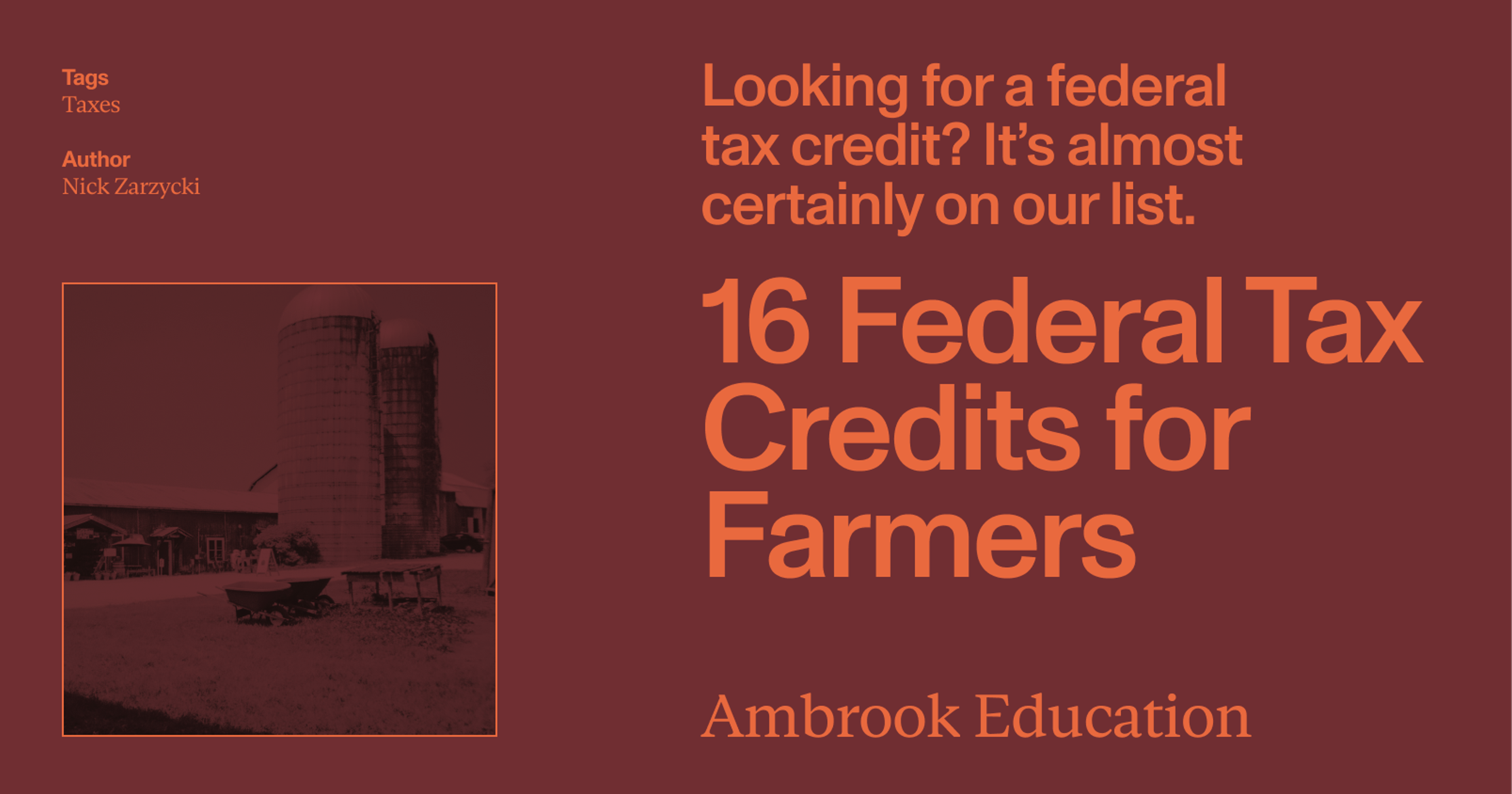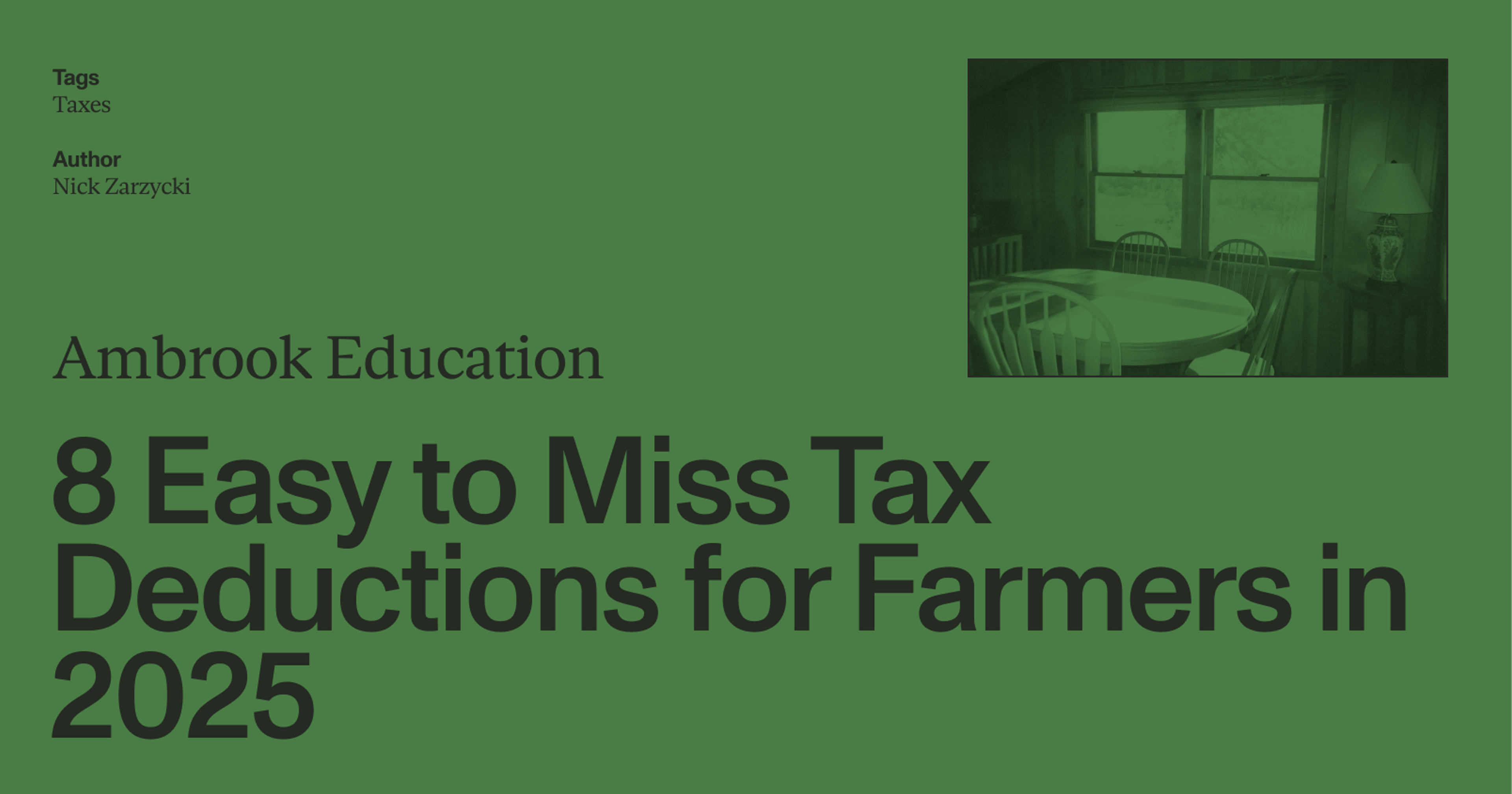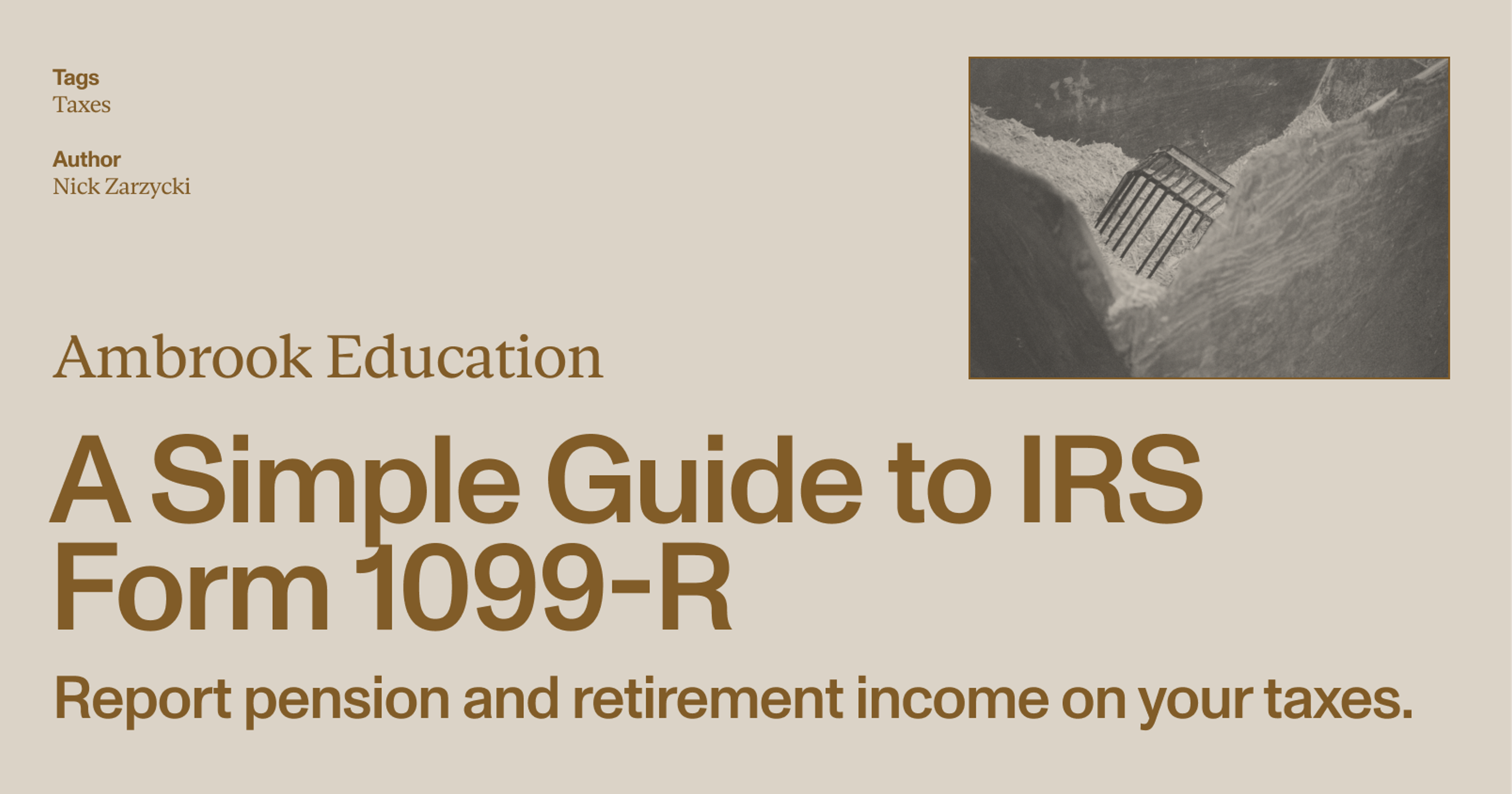A definitive list of federal tax credits for farmers, ranchers and ag businesses.
Tax credits are powerful. Unlike deductions, which lower your tax bill indirectly, credits decrease it dollar-for-dollar: $100 in tax credits is $100 moving directly back into your pocket.
Here we’ve assembled the definitive list of federal tax credits relevant to U.S. farmers, ranchers and other agriculture businesses, listing their official name and the IRS tax form you need to calculate or claim them. (Head over to our guide to state tax credits for a rundown of state programs.)
Also remember that because most of these credits fall under the “General Business Credit,” you’ll need to file Form 3800 to add them up and properly claim them on your return.
Biofuel Producer Credit (Form 6478)
Also known as the ‘alcohol used as fuel credit,’ you can claim this if you produce and either sell or use biofuels, which includes fuels derived from feedstocks like corn or wheat, biodiesel made from vegetable or animal fats, biogas, or other qualifying biofuels.
The benefit equals $1.01 per gallon of fuel sold or used in an eligible trade or business, and only biofuel producers (not distributors or retailers) can claim it. Learn more about eligibility requirements and what exactly qualifies as a biofuel in the instructions to Form 6478.
Credit for Employer Social Security and Medicare Taxes Paid on Certain Employee Tips (Form 8846)
This credit is available to food and beverage establishments, and allows employers to recover a portion of the payroll taxes they pay on tips received by their employees in excess of the federal minimum wage. (Employers typically have to pay payroll taxes on all employee income, including tips.)
Child Tax Credit (CTC)
In July 2025, OBBBA permanently increased the federal Child Tax Credit (CTC) for qualifying children under the age of 17 to $2,200 and indexed it for inflation starting 2026. (It also made the $500 nonrefundable Credit for Other Dependants who don’t qualify for the CTC permanent.)
The child must be claimed as a dependent on your tax return and live with you, and the credit phases out if your adjusted gross income exceeds $200,000 (or $400,000 if you’re married and filing jointly). Read more about the CTC eligibility requirements on the IRS website.
Clean Vehicle Credit (Form 8936) - Expires Sept. 30, 2025
Businesses that purchase new or used electric vehicles, plug-in hybrids, and fuel cell vehicles can receive a credit of up to $7,500 for new vehicles and $4,000 for used vehicles that meet specific eligibility criteria and are purchased through a qualified dealer. Due to recent legislative changes, however, these credits are expiring on September 30, 2025. To claim them on your 2026 return, you’ll have to purchase the vehicle before that due date.
Vehicles must have a gross weight of less than 14,000 pounds, have their final assembly in North America, and cannot have an MSRP of more than $55,000 (or $80,000 for a van, SUVs or pickup trucks). Qualifying vehicles include low-speed electric vehicles, two- or three-wheeled plug-in vehicles, certain industrial vehicles used in warehouses and some electric vehicles used on farms. See the instructions to Form 8936 for a full list of criteria, and see the ‘Qualified Plug-in Electric and Electric Vehicle Credit’ below for claiming vehicles that don’t fall under the Clean Vehicle Credit.
Read more: Claim These Green Tax Credits Before They Expire
Credit for Increasing Research Activities (Form 6765)
The ‘R&D tax credit’ allows businesses to claim qualified research expenses, which for farmers can include things like experimenting with new planting methods, irrigation systems, fertilizers and soil blends; testing new methods for pest and disease control; researching new breeding methods and techniques for feeding; and implementing new harvesting techniques.
You can generally claim either 20 percent of any excess qualified research expenses, or use the alternative simplified credit (ASC) rules, which involve more complicated calculations.
If you have little or no income tax liability, you can use the R&D credit to offset your payroll tax liability.
For tax years beginning before January 1, 2023, the maximum payroll tax offset was $250,000, and for tax years beginning on or after that date, the maximum is $500,000. If you use the credit to reduce payroll taxes, first reduce the employer’s share of Social Security, then reduce the employer’s share of Medicare.
Many federal and state grant programs target activities eligible for R&D tax credits, so be sure to consult our Funding Library for funding suggestions relevant to your operation.
Also note that in addition to Form 6765, you might have to file Form 941 and Form 8974 to claim this credit. Consult the IRS’s instructions to Form 6765, the official guide to the Research Payroll Tax Credit or your tax preparer for more information.
Credit for Small Employer Pension Plan Startup Costs (Form 8881)
Also known as the ‘retirement plans startup costs tax credit,’ small businesses can use this credit to offset the cost of setting up a pension plan, SEP IRA, SIMPLE IRA, or 401(k) for their employees. You’re eligible if you employ no more than 100 employees and if you didn’t have an employer-sponsored retirement plan in place in the previous three years.
Only employees you’ve paid at least $5,000 over the course of the year count toward the employee total. The credit covers between 50-100% of eligible startup costs, up to $5,000 total, depending on the exact number of eligible employees you have. You can find a detailed breakdown of the calculations on the IRS website and the instructions to Form 8881.
Disabled Access Credit (Form 8826)
If you made your business more accessible to people with disabilities–by removing barriers, acquiring special equipment or hiring interpreters, for example–you might be able to claim 50% of those expenditures, up to a maximum of $5,000 per year.
Only businesses that earned $1 million or less or had no more than 30 full-time employees in the previous year are eligible. However, businesses of any size can claim the ‘architectural barrier removal tax deduction,’ a separate benefit that allows businesses to deduct up to $15,000 spent on removing architectural and transportation barriers–by installing accessibility ramps, stair lifts, and grab bars, for example.
Earned Income Tax Credit (EITC)
The EITC is a tax break for low-income workers and families with four different eligibility thresholds based on the number of qualifying children you have.
Here are the limits for 2024 tax returns:
| Your annual income (if single): | Your income (if married filing jointly): | The number of qualifying children you have: | Your maximum annual EITC: |
|---|---|---|---|
| $59,899 | $66,819 | Three or more | $7,830 |
| $55,768 | $62,688 | Two | $6,960 |
| $49,084 | $56,004 | One | $4,213 |
| $18,591 | $25,511 | Zero | $632 |
You can use the IRS’s Earned Income Tax Credit Assistant to check your eligibility and maximum credit amount.
Employer Credit for Paid Family and Medical Leave (Form 8994)
If you offer paid family and medical leave to your employees, you might be able to claim between 12.5% and 25% of the leave wages you pay them using this credit. Employers must have a written policy in place, employees need to have been employed for at least a year in order to qualify, and there are thresholds for ‘highly compensated employees’ who earn above a certain amount. Consult the instructions to Form 8994 for a full breakdown of who’s eligible and how to calculate the credit.
Empowerment Zone Employment Credit (Form 8844)
This credit allows employers to claim a percentage of the wages paid to employees living in “empowerment zones,” which are economically distressed rural and urban areas designated by the Department of Housing and Urban Development and the USDA. Employees must work at least 90 days of the year in which the credit is being claimed and employers can claim up to 20% of the first $15,000 paid, for a maximum of $3,000 per employee. Consult the instructions to Form 8844 for a complete list of empowerment zones and eligibility criteria.
Fuel Excise Tax Credit or Refund
Farm owners, operators and tenants might be able to claim a credit or refund of excise taxes on fuel if they used the fuel on a farm for farming purposes, for off-highway business use, or for household use, depending on the type of fuel used.
Businesses can claim this benefit in the form of a quarterly refund (using Form 8849) or an annual credit (using Form 4136) depending on the amount claimed. For more on how to claim the benefit, recordkeeping requirements, and which fuel uses qualify, consult Part 14 of the IRS Farmer’s Tax Guide: ‘Fuel Excise Tax Credits and Refunds.’
Investment Credits for Rehabilitation, Coal, Gasification and Advanced Energy Projects (Form 3468)
You can use Form 3468 to claim various credits for energy-related investments you make to your property, including:
The Qualifying Advanced Coal Project Credit for advanced coal-based generation technology that separates and sequesters at least 65% of the project’s total carbon dioxide emissions.
The Qualifying Gasification Project Credit for gasification technology that converts solid or liquid products from coal, petroleum, biomass, or other materials which are recovered for their energy or feedstock value into gas that can be converted to energy.
The Qualifying Advanced Energy Project Credit for establishing or expanding renewable solar, wind, water and geothermal energy sources, renewable energy storage systems and components, grid modernization, and other investments related to advanced energy projects.
The Energy Investment Credit for geothermal energy, solar energy, fuel cell, microturbine, small wind energy, waste energy recovery, biogas and other renewable energy properties outlined in the instructions to Form 3468.
The Rehabilitation Credit for substantial investments you make in the rehabilitation of certified historic structures on your property.
New Markets Credit (Form 8874)
The New Markets Tax Credit (NMTC) program stimulates investment in economically distressed communities by offering tax credits to investors who make investments in Community Development Entities (CDEs). Investors receive a tax credit totaling 39% of their investment, claimed over seven years, which can significantly offset federal income tax liability.
Renewable Electricity Production Credit (Form 8835)
You could qualify for this credit if you generate electricity from renewable sources on your property via qualifying renewable energy sources and use it in your operations or sell excess electricity to the grid.
The credit is based on how much energy you generate, and can go up to 1.5 cents/kWh for electricity generated from landfill gas (LFG), open-loop biomass, solid waste or small irrigation power, and up to 2.75 cents/kWh for wind, closed-loop biomass and geothermal.
Work Opportunity Credit (Form 5884)
Employers can claim this credit for hiring certain eligible individuals who have consistently faced significant barriers to employment, including people with disabilities, veterans, convicted felons, and residents living in economically distressed communities.
The maximum credit per employee for employees who work 400 or more hours is $2,400, or 40% of up to $6,000 of first year wages. For certain qualified veterans, that amount goes up to $9,600 or 40% of up to $24,000 of first year wages. For individuals who work at least 120 hours but less than 400 hours, a 25% rate applies to wages paid.
To claim the credit, employers have to file IRS Form 8850 with their state workforce agency (not the IRS) within 28 days of the employment start date. Consult the IRS’s guide to the Work Opportunity Credit for more information.
Credit for Small Employer Health Insurance Premiums (Form 8941)
This credit is available to small businesses that offer health care insurance to their employees. To qualify for the credit, you must:
Have fewer than 25 full-time equivalent employees
Pay average wages of less than that year’s cap (which changes each year based on inflation)
Offer a qualified health plan to employees through the Small Business Health Options Program (SHOP) marketplace.
Pay at least 50% of the cost of the employee’s coverage
The credit is worth up to 50% of the premiums you pay, and it’s available for up to two consecutive tax years. You can find more information about the credit on the IRS website.
Make tax season less taxing with Ambrook
Ambrook’s Schedule F category tags are tailor-made for agriculture businesses, saving you hours on tax prep. With features like automated financial reporting, simplified bookkeeping, and effortless bill pay and invoicing, Ambrook is more than just a farm tax and accounting tool: it takes the guesswork out of running your business. Want to learn more? Start your 7 day free trial today.
Want to learn more about Ambrook?
This resource is provided for general informational purposes only. It does not constitute professional tax, legal, or accounting advice. The information may not apply to your specific situation. Please consult with a qualified tax professional regarding your individual circumstances before making any tax-related decisions.








